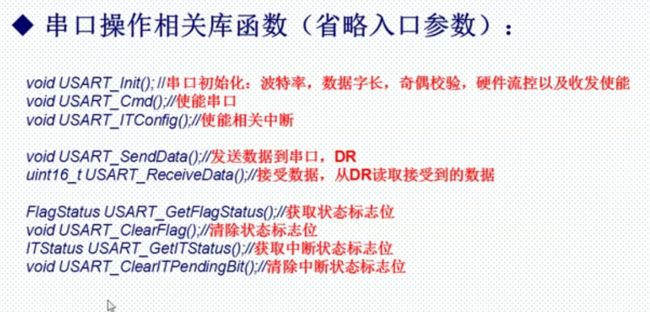Stm32串口通信(UART)
串口通信的分类
串口通信三种传递方式
串口通信的通信方式
串行通信的方式: 异步通信:它用一个起始位表示字符的开始,用停止位表示字符的结束。其每帧的格式如下: 在一帧格式中,先是一个起始位0,然后是8个数据位,规定低位在前,高位在后,接下来是奇偶校验位(能省略),最后是停止位1。用这种格式表示字符,则字符能一个接一个地传送。 在异步通信中,CPU与外设之间必须有两项规定,即字符格式和波特率。字符格式的规定是双方能够在对同一种0和1的串理解成同一种意义。原则上字符格式能由通信的双方自由制定,但从通用、方便的角度出发,一般还是使用一些标准为好,如采用ASCII标准。 波特率即数据传送的速率,其定义是每秒钟传送的二进制数的位数。例如,数据传送的速率是120字符/s,而每个字符如上述规定包含10数位,则传送波特率为1200波特。 同步通信:在同步通信中,每个字符要用起始位和停止位作为字符开始和结束的标志,占用了时间;所以在数据块传递时,为了提高速度,常去掉这些标志,采用同步传送。由于数据块传递开始要用同步字符来指示,同时要求由时钟来实现发送端与接收端之间的同步,故硬件较复杂。
USART通信
USART异步通信方式特点
USART异步通信
串口通信示例程序
#include "stm32f10x.h" void My_USARTI_Init(void) { GPIO_InitTypeDef GPIO_InitStructure;//定义GPIO结构体 USART_InitTypeDef USART_InitStrue;//定义USART结构体 NVIC_InitTypeDef NVIC_InitStruct;//定义NVTO结构体 RCC_APB2PeriphClockCmd(RCC_APB2Periph_GPIOA,ENABLE);//使能GPIOA RCC_APB2PeriphClockCmd(RCC_APB2Periph_USART1,ENABLE);//使能USART1 //GPIOA.9,复用推挽输出 GPIO_InitStructure.GPIO_Pin =GPIO_Pin_9; GPIO_InitStructure.GPIO_Mode=GPIO_Mode_AF_PP; GPIO_InitStructure.GPIO_Speed=GPIO_Speed_10MHz; GPIO_Init(GPIOA,&GPIO_InitStructure); //GPIOA.10上浮输入 GPIO_InitStructure.GPIO_Pin =GPIO_Pin_10; GPIO_InitStructure.GPIO_Mode=GPIO_Mode_IN_FLOATING; GPIO_InitStructure.GPIO_Speed=GPIO_Speed_10MHz; GPIO_Init(GPIOA,&GPIO_InitStructure); //串口初始化 USART_InitStrue.USART_Mode= USART_Mode_Rx | USART_Mode_Tx; USART_InitStrue.USART_BaudRate=115200;//波特率 USART_InitStrue.USART_HardwareFlowControl=USART_HardwareFlowControl_None;//不使用硬件流 USART_InitStrue.USART_Parity=USART_Parity_No;//不用奇偶验证 USART_InitStrue.USART_StopBits=USART_StopBits_1;//停止位 USART_InitStrue.USART_WordLength=USART_WordLength_8b;//数据位 USART_Init(USART1,&USART_InitStrue); //使能串口1 USART_Cmd(USART1,ENABLE); //开启接收中断,接收到数据就会执行中断函数 USART_ITConfig(USART1,USART_IT_RXNE,ENABLE); //中断优先级设置 NVIC_InitStruct.NVIC_IRQChannel=USART1_IRQn;//stm32f10x.h文件的顶部查找 NVIC_InitStruct.NVIC_IRQChannelCmd=ENABLE; NVIC_InitStruct.NVIC_IRQChannelPreemptionPriority=1; NVIC_InitStruct.NVIC_IRQChannelSubPriority=1; NVIC_Init(&NVIC_InitStruct); } //中断服务函数 void USART1_IRQHandler(void) { u8 res; if(USART_GetITStatus(USART1,USART_IT_RXNE)) { //读取串口的数据 res=USART_ReceiveData(USART1); USART_SendData(USART1,res); } } //电脑每给开发板发送一次数据,就会触发中断//接下来执行一次中断服务函数//res=USART_ReceiveData(USART1)就会接收到数据 //USART_SendData(USART1,res)又把接收到的数据发送给电脑,在串口助手就能看到 int main(void) { //系统中断优先级分组为2 NVIC_PriorityGroupConfig(NVIC_PriorityGroup_2); My_USARTI_Init(); while(1) { } }
完整的官方示例代码
usart.h
#ifndef __USART_H #define __USART_H #include "stdio.h" #include "sys.h" #define USART_REC_LEN 200 //定义最大接收字节数 200 #define EN_USART1_RX 1 //使能(1)/禁止(0)串口1接收 extern u8 USART_RX_BUF[USART_REC_LEN]; //接收缓冲,最大USART_REC_LEN个字节.末字节为换行符 extern u16 USART_RX_STA; //接收状态标记 //如果想串口中断接收,请不要注释以下宏定义 void uart_init(u32 bound); #endif
usart.c
#include "sys.h" #include "usart.h" //如果使用ucos,则包括下面的头文件即可. #if SYSTEM_SUPPORT_OS #include "includes.h" //ucos 使用 #endif ////////////////////////////////////////////////////////////////// //加入以下代码,支持printf函数,而不需要选择use MicroLIB #if 1 #pragma import(__use_no_semihosting) //标准库需要的支持函数 struct __FILE { int handle; }; FILE __stdout; //定义_sys_exit()以避免使用半主机模式 _sys_exit(int x) { x = x; } //重定义fputc函数 int fputc(int ch, FILE *f) { while((USART1->SR&0X40)==0);//循环发送,直到发送完毕 USART1->DR = (u8) ch; return ch; } #endif /*使用microLib的方法*/ /* int fputc(int ch, FILE *f) { USART_SendData(USART1, (uint8_t) ch); while (USART_GetFlagStatus(USART1, USART_FLAG_TC) == RESET) {} return ch; } int GetKey (void) { while (!(USART1->SR & USART_FLAG_RXNE)); return ((int)(USART1->DR & 0x1FF)); } */ #if EN_USART1_RX //如果使能了接收 //串口1中断服务程序 //注意,读取USARTx->SR能避免莫名其妙的错误 u8 USART_RX_BUF[USART_REC_LEN]; //接收缓冲,最大USART_REC_LEN个字节. //接收状态 //bit15, 接收完成标志 //bit14, 接收到0x0d //bit13~0, 接收到的有效字节数目 u16 USART_RX_STA=0; //接收状态标记 void uart_init(u32 bound){ //GPIO端口设置 GPIO_InitTypeDef GPIO_InitStructure; USART_InitTypeDef USART_InitStructure; NVIC_InitTypeDef NVIC_InitStructure; RCC_APB2PeriphClockCmd(RCC_APB2Periph_USART1|RCC_APB2Periph_GPIOA, ENABLE); //使能USART1,GPIOA时钟 //USART1_TX GPIOA.9 GPIO_InitStructure.GPIO_Pin = GPIO_Pin_9; //PA.9 GPIO_InitStructure.GPIO_Speed = GPIO_Speed_50MHz; GPIO_InitStructure.GPIO_Mode = GPIO_Mode_AF_PP; //复用推挽输出 GPIO_Init(GPIOA, &GPIO_InitStructure);//初始化GPIOA.9 //USART1_RX GPIOA.10初始化 GPIO_InitStructure.GPIO_Pin = GPIO_Pin_10;//PA10 GPIO_InitStructure.GPIO_Mode = GPIO_Mode_IN_FLOATING;//浮空输入 GPIO_Init(GPIOA, &GPIO_InitStructure);//初始化GPIOA.10 //Usart1 NVIC 配置 NVIC_InitStructure.NVIC_IRQChannel = USART1_IRQn; NVIC_InitStructure.NVIC_IRQChannelPreemptionPriority=3 ;//抢占优先级3 NVIC_InitStructure.NVIC_IRQChannelSubPriority = 3; //子优先级3 NVIC_InitStructure.NVIC_IRQChannelCmd = ENABLE; //IRQ通道使能 NVIC_Init(&NVIC_InitStructure); //根据指定的参数初始化VIC寄存器 //USART 初始化设置 USART_InitStructure.USART_BaudRate = bound;//串口波特率 USART_InitStructure.USART_WordLength = USART_WordLength_8b;//字长为8位数据格式 USART_InitStructure.USART_StopBits = USART_StopBits_1;//一个停止位 USART_InitStructure.USART_Parity = USART_Parity_No;//无奇偶校验位 USART_InitStructure.USART_HardwareFlowControl = USART_HardwareFlowControl_None;//无硬件数据流控制 USART_InitStructure.USART_Mode = USART_Mode_Rx | USART_Mode_Tx; //收发模式 USART_Init(USART1, &USART_InitStructure); //初始化串口1 USART_ITConfig(USART1, USART_IT_RXNE, ENABLE);//开启串口接受中断 USART_Cmd(USART1, ENABLE); //使能串口1 } void USART1_IRQHandler(void) //串口1中断服务程序 { u8 Res; #if SYSTEM_SUPPORT_OS //如果SYSTEM_SUPPORT_OS为真,则需要支持OS. OSIntEnter(); #endif if(USART_GetITStatus(USART1, USART_IT_RXNE) != RESET) //接收中断(接收到的数据必须是0x0d 0x0a结尾) { Res =USART_ReceiveData(USART1); //读取接收到的数据 if((USART_RX_STA&0x8000)==0)//接收未完成 { if(USART_RX_STA&0x4000)//接收到了0x0d { if(Res!=0x0a)USART_RX_STA=0;//接收错误,重新开始 else USART_RX_STA|=0x8000; //接收完成了 } else //还没收到0X0D { if(Res==0x0d)USART_RX_STA|=0x4000; else { USART_RX_BUF[USART_RX_STA&0X3FFF]=Res ; USART_RX_STA++; if(USART_RX_STA>(USART_REC_LEN-1))USART_RX_STA=0;//接收数据错误,重新开始接收 } } } } #if SYSTEM_SUPPORT_OS //如果SYSTEM_SUPPORT_OS为真,则需要支持OS. OSIntExit(); #endif } #endif
main.c
#include "stm32f10x.h" void My_USARTI_Init(void) { GPIO_InitTypeDef GPIO_InitStructure;//定义GPIO结构体 USART_InitTypeDef USART_InitStrue;//定义USART结构体 NVIC_InitTypeDef NVIC_InitStruct;//定义NVIC结构体 RCC_APB2PeriphClockCmd(RCC_APB2Periph_GPIOA,ENABLE);//使能GPIOA RCC_APB2PeriphClockCmd(RCC_APB2Periph_USART1,ENABLE);//使能USART1 //GPIOA.9,复用推挽输出 GPIO_InitStructure.GPIO_Pin =GPIO_Pin_9; GPIO_InitStructure.GPIO_Mode=GPIO_Mode_Out_PP; GPIO_InitStructure.GPIO_Speed=GPIO_Speed_10MHz; GPIO_Init(GPIOA,&GPIO_InitStructure); //GPIOA.10,上浮输入 GPIO_InitStructure.GPIO_Pin =GPIO_Pin_10; GPIO_InitStructure.GPIO_Mode=GPIO_Mode_IN_FLOATING; GPIO_InitStructure.GPIO_Speed=GPIO_Speed_10MHz; GPIO_Init(GPIOA,&GPIO_InitStructure); //串口初始化 USART_InitStrue.USART_Mode= USART_Mode_Rx | USART_Mode_Tx; USART_InitStrue.USART_BaudRate=115200;//波特率 USART_InitStrue.USART_HardwareFlowControl=USART_HardwareFlowControl_None;//不使用硬件流 USART_InitStrue.USART_Parity=USART_Parity_No;//不用奇偶验证 USART_InitStrue.USART_StopBits=USART_StopBits_1;//停止位 USART_InitStrue.USART_WordLength=USART_WordLength_8b;//数据位 USART_Init(USART1,&USART_InitStrue); //使能串口1 USART_Cmd(USART1,ENABLE); //开启接收中断,接收到数据就会执行中断函数 USART_ITConfig(USART1,USART_IT_RXNE,ENABLE); //中断优先级设置 NVIC_InitStruct.NVIC_IRQChannel=USART1_IRQn;//stm32f10x.h文件顶部查找 NVIC_InitStruct.NVIC_IRQChannelCmd=ENABLE; NVIC_InitStruct.NVIC_IRQChannelPreemptionPriority=1; NVIC_InitStruct.NVIC_IRQChannelSubPriority=1; NVIC_Init(&NVIC_InitStruct); } void USART1_IRQHandler(void) { u8 res; if(USART_GetITStatus(USART1,USART_IT_RXNE)) { //读取串口的数据 res=USART_ReceiveData(USART1); USART_SendData(USART1,res); } } //电脑每给开发板发送一次数据,就会触发中断 //就会执行一次中断服务函数 //res=USART_ReceiveData(USART1)就会接收到数据 //USART_SendData(USART1,res)又把接收到的数据发送给电脑,在串口助手就能看到 int main(void) { //系统中断优先级分组为2 NVIC_PriorityGroupConfig(NVIC_PriorityGroup_2); My_USARTI_Init(); while(1) { } }







